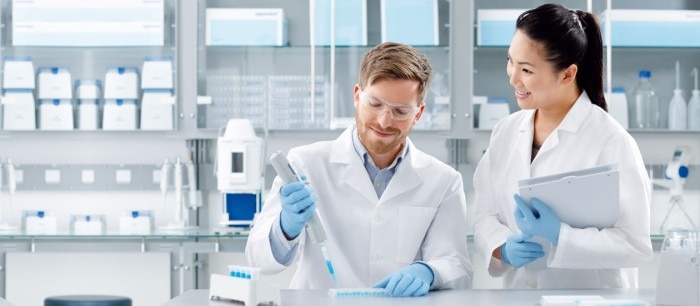MENÚ
AR | ARS
AR | ARS
-
- Pipeteo manual & dispensación
- Pipetas mecánicas
- Pipetas electrónicas
- Pipetas multicanal
- Pipetas de desplazamiento positivo y dispensadores
- Pipeteo automatizado
- Dispensadores de botella
- Controladores de pipeta
- Puntas de pipeta
- Consumibles de automatización
- Accesorios para dispensadores y pipetas
- Accesorios de automatización
- Servicios para dispensadores y pipetas
Está a punto de abandonar este sitio.
Por favor, tenga en cuenta que su carro de la compra actual no ha sido guardado todavía y no podrá ser restablecido en el nuevo sitio ni cuando regrese. Si desea guardar su carro de la compra, inicie sesión en su cuenta.
No se han encontrado resultados
Sugerencias de búsqueda

When You Think about Pipetting Liquids, Think Twice
Academia de laboratorio
- Biología celular
- Rutina de laboratorio
- Soluciones digitales de laboratorio
- Pipetas
- Ensayo
Starting an experiment means asking many questions. Which material is needed? Which samples are used? Which conditions are necessary, e.g., growth? How long is the whole application? Do I have to check on the experiment at weekends, or at night? One question is often forgotten, but is of no less importance. Which liquids are used during the application and how are they pipetted?
Since pipetting liquids is daily business and if the liquid aspirated is also dispensed, we usually don’t spend too much time and effort on this topic. But it makes sense to think twice about the liquid and pipette tool used.
Liquids can be categorized in five main categories: aqueous, viscous (incl. detergents), volatile, dense and infectious or toxic. Improper handling of these liquid categories has a tremendous influence on the pipetting result. While pipetting aqueous solutions like most buffers is fairly simple and mainly done with classic air-cushion pipettes, difficulties may arise when pipetting volatile liquids like acetone. Volatile liquids have a high vapor pressure causing evaporation into the air-cushion and thereby droplet formation. In the end, this means sample or reagent loss without the correct pipetting technique. When pipetting volatile liquids, pre-wetting of the pipette tip (repeated aspiration and dispensing cycles to humidify the air inside the tip) is mandatory to increase pipetting accuracy. A completely different liquid category includes viscous liquids such as glycerol. These have a very slow flow behavior due to a high inner friction of molecules leading to air bubble aspiration, residues in the tip and sample or reagent loss. A special pipetting technique called reverse pipetting is recommended when using classic air-cushion pipettes. But even better is usage of a different pipetting tool, a positive displacement device with a syringe-like tip working without an air cushion between the sample and the piston inside the tip. Liquid can be aspirated faster and easier with these tools. When dispensing a viscous liquid, the complete volume can be dispensed without residues in the tip.
So, thinking about the liquid before starting an experiment can simplify and improve your workflow and results. An overview of the liquid categories, their challenges and recommendations on proper pipetting techniques and pipetting tools are shown on our poster. You may download the poster to have a printable version for your lab.
Liquids can be categorized in five main categories: aqueous, viscous (incl. detergents), volatile, dense and infectious or toxic. Improper handling of these liquid categories has a tremendous influence on the pipetting result. While pipetting aqueous solutions like most buffers is fairly simple and mainly done with classic air-cushion pipettes, difficulties may arise when pipetting volatile liquids like acetone. Volatile liquids have a high vapor pressure causing evaporation into the air-cushion and thereby droplet formation. In the end, this means sample or reagent loss without the correct pipetting technique. When pipetting volatile liquids, pre-wetting of the pipette tip (repeated aspiration and dispensing cycles to humidify the air inside the tip) is mandatory to increase pipetting accuracy. A completely different liquid category includes viscous liquids such as glycerol. These have a very slow flow behavior due to a high inner friction of molecules leading to air bubble aspiration, residues in the tip and sample or reagent loss. A special pipetting technique called reverse pipetting is recommended when using classic air-cushion pipettes. But even better is usage of a different pipetting tool, a positive displacement device with a syringe-like tip working without an air cushion between the sample and the piston inside the tip. Liquid can be aspirated faster and easier with these tools. When dispensing a viscous liquid, the complete volume can be dispensed without residues in the tip.
So, thinking about the liquid before starting an experiment can simplify and improve your workflow and results. An overview of the liquid categories, their challenges and recommendations on proper pipetting techniques and pipetting tools are shown on our poster. You may download the poster to have a printable version for your lab.
Leer más
Leer menos
Related Document
- PDF Poster: Master your challenging liquids
Leer más
Leer menos
